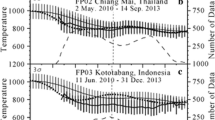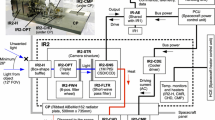Abstract
A scanning Fabry–Perot interferometer (SFPI) was first developed and deployed at the Langfang near Space Environment Field Scientific Observation Station (39.38°N, 116.65°E) of the National Space Science Center, CAS. The instrument is designed to measure the mesospheric and thermospheric wind velocities using the atomic oxygen 557.7-nm and 630.0-nm emissions. Data from February 28 to March 3 and February 28 to March 15 in 2011 were chosen for case study and mean value study, respectively. The errors of the meridional and zonal winds are 6.5 and 7.5 m/s at 557.7-nm and at 630.0-nm, they are 7.1 and 6.6 m/s, respectively. During the whole experiment, the instrument has performed in good condition and provided high-quality data. The mean neutral wind data were consistent with that predicted by HWM07. Good agreement has been found in between the SFPI and a neighbor Meridian Project Fabry–Perot interferometer (MP FPI), with a corresponding coefficient (r 2) larger than 80 %. In general, the scanning FPI meets the design goal, and it is a useful ground-based instrument for measuring mesospheric and thermospheric winds at middle latitudes and is able to provide high-quality data for future scientific studies.







Similar content being viewed by others
References
Greenaway D (1983) Doppler imaging system; an optical device for measuring vector winds. 1: general principles. Appl Opt 22:1078–1083
Dyson PL, Davies TP, Parkinson ML et al (1997) Thermospheric neutral winds at southern mid-latitudes: a comparison of optical and ionosonde hmF2 methods. J Geophys Res 102:27189–27196
Campbell L, Brunger MJ (2010) Modeling of kinetic, ionospheric and auroral contributions to the 557.7-nm nightglow. Geophys Res Lett 37:L22104
Didebulidze GG, Lomidze LN, Gudadze NB et al (2011) Long-term changes in the nightly behaviour of the oxygen red 630.0 nm line nightglow intensity and trends in the thermospheric meridional wind velocity. Int J Remote Sens 32:3093–3114
Kudeki E, Akgiray A, Milla M et al (2007) Equatorial spread-F initiation: post-sunset vortex, thermospheric winds, gravity waves. J Atmos Sol-Terr Phys 69:2416–2427
Malik R, Sarkar S, Mukherjee S et al (2010) Study of ionospheric variability during geomagnetic storms. J Ind Geophys Union 14:47–56
Klimenko MV, Klimenko VV, Ratovsky KG et al (2011) Disturbances in the ionospheric F-region peak heights in the American longitudinal sector during geomagnetic storms of September 2005. Adv Space Res 48:1184–1195
Yuan W, Xu JY, Ma RP et al (2010) First observation of mesospheric and thermospheric winds by a Fabry–Perot interferometer in China. Chin Sci Bull 55:4046–4051
Hu GY (2010) Development of mobile doppler imaging Fabry–Perot Interferometer for atmospheric wind measurement. Doctor Dissertation, Wuhan: Wuhan University (in Chinese)
Wu Q, Gablehouse RD, Solomon SC et al (2004) A new Fabry–Perot interferometer for upper atmosphere research. Proc SPIE Int Soc Opt Photonics 5660:218–227
Shiokawa K, Kadota T, Otsuka Y et al (2003) A two-channel Fabry–Perot interferometer with thermoelectric-cooled CCD detectors for neutral wind measurement in the upper atmosphere. Earth Planets Space 55:271–275
Griffin EM, Muller-Wodarg ICF, Aruliah A et al (2004) Comparison of high-latitude thermospheric meridional winds I: optical and radar experimental comparisons. Ann Geophys 22:849–862
Smith RW (1998) Vertical winds: a tutorial. J Atmos Sol-Terr Phys 60:1425–1434
Hernandez G (1966) Analytical description of a Fabry–Perot photoelectric spectrometer. Appl Opt 5:1745–1748
Hays PB, Roble RG (1971) A technique for recovering Doppler line profiles from Fabry–Perot interferometer fringes of very low intensity. Appl Opt 10:193–200
Biondi MA, Sipler DP, Zipf ME et al (1995) All-sky Doppler interferometer for thermospheric dynamics studies. Appl Opt 34:1646–1654
Nakajima H, Okano S, Fukunishi H et al (1995) Observations of thermospheric wind velocities and temperatures by the use of a Fabry–Perot Doppler imaging system at Syowa Station, Antarctica. Appl Opt 34:8382–8395
Kosch MJ, Ishii M, Nozawa S et al (2000) A comparison of thermospheric winds and temperatures from Fabry–Perot interferometer and EISCAT radar measurements with models. Adv Space Res 26:979–984
Picone JM, Hedin AE, Drob DP et al (2002) NRLMSISE-00 empirical model of the atmosphere: Statistical comparisons and scientific issues. J Geophys Res 107: SIA 15-11–SIA 15-16
Drob DP, Emmert JT, Crowley G et al (2008) An empirical model of the Earth’s horizontal wind fields: HWM07. J Geophys Res 113:A12304
Anderson C, Conde M, Dyson P et al (2009) Thermospheric winds and temperatures above Mawson, Antarctica, observed with an all-sky imaging, Fabry–Perot spectrometer. Ann Geophys 27:2225–2235
Acknowledgments
This study was supported by the National High-tech R&D Program of China (2008AA7033050, 2009AA7033050, and 2010AA7033050). The authors thank the partners of the Center for Space Science and Applied Research, CAS, for their kind data support and useful discussions. The authors also thank two anonymous reviewers whose constructive comments are much helpful in improving the quality of the paper.
Author information
Authors and Affiliations
Corresponding author
About this article
Cite this article
Hu, G., Ai, Y., Zhang, Y. et al. First scanning Fabry–Perot interferometer developed in China. Chin. Sci. Bull. 59, 563–570 (2014). https://doi.org/10.1007/s11434-013-0093-5
Received:
Accepted:
Published:
Issue Date:
DOI: https://doi.org/10.1007/s11434-013-0093-5




